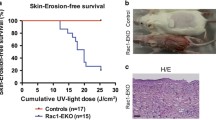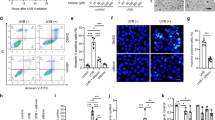Abstract
Sun-induced skin lesions, in particular actinic keratosis, are generally considered as premalignant skin lesions that can progress into squamous cell carcinoma (SCC) and invasive SCC if left untreated. Therefore, understanding the molecular mechanisms by which the ultraviolet-B (UV-B)-exposed cells are being protected and the signaling pathways that promote the progression of certain premalignant skin lesions to malignant lesions will permit us to prevent or cure skin cancers. In the current study, we found that phospho-p21-activated kinase-1 (Pak1) and Pak1 expression was high in clinical samples of sunlight-induced premalignant skin lesions assessed by immunohistochemistry. Further, we observed that phospho-Pak1 and Pak1 levels are high in UV-B-exposed hairless SKH mouse model skin samples as compared with unexposed skin tissue. Our results from cell line and animal models showed that Pak1 is activated in response to UV-B radiation, and this activated Pak1 translocates from the cytoplasm to the nucleus. Inside the nucleus, Pak1 via C-Fos binds to a specific promoter region of DNA repair kinase ATR (ataxia–telangiectasia and Rad3-related protein) and acts as a transcriptional regulator of ATR. Results from our analysis showed that Pak1 overexpression, knockdown and Pak1 knockout cell line models showed that Pak1 confers protection to keratinocytes from UV-B-induced apoptosis and DNA damage via ATR. To our knowledge, this is the first study that evaluates the functional and clinical significance of a signaling molecule, Pak1, in sun-induced premalignant skin lesions and indicates that increased Pak1 activation and expression could serve as an early warning sign of progression toward non-melanoma skin cancer, if ignored.







Similar content being viewed by others
References
Panda S . Nonmelanoma skin cancer in India: current scenario. Indian J Dermatol 2010; 55: 373–378.
Corona R . Epidemiology of nonmelanoma skin cancer. Ann Ist Super Sanita 1996; 32: 37–42.
Ichihashi M, Ueda M, Budiyanto A, Bito T, Oka M, Fukunaga M et al. UV-induced skin damage. Toxicology 2003; 189: 21–39.
Marks VJ . Actinic keratosis. A premalignant skin lesion. Otolaryngol Clin North Am 1993; 26: 23–35.
Bhat Mr, Dandakeri S, Gatti R, Hulmani M, Kambil S . Disseminated discoid lupus erythematosus leading to squamous cell carcinoma. Indian J Dermatol 2012; 57: 158–161.
Criscione VD, Weinstock MA, Naylor MF, Luque C, Eide MJ, Bingham SF et al. Actinic keratoses: natural history and risk of malignant transformation in the Veterans Affairs Topical Tretinoin Chemoprevention Trial. Cancer 2009; 115: 2523–2530.
Anna B, Blazej Z, Jacqueline G, Andrew CJ, Jeffrey R, Andrzej S . Mechanism of UV-related carcinogenesis and its contribution to nevi/melanoma. Expert Rev Dermatol 2007; 2: 451–469.
Cooper SJ, Bowden GT . Ultraviolet B regulation of transcription factor families: roles of nuclear factor-kappa B (NF-kappaB) and activator protein-1 (AP-1) in UVB-induced skin carcinogenesis. Curr Cancer Drug Targets 2007; 7: 325–334.
Ghosal G, Chen J . DNA damage tolerance: a double-edged sword guarding the genome. Transl Cancer Res 2013; 2: 107–129.
Ward IM, Minn K, Chen J . UV-induced ataxia-telangiectasia-mutated and Rad3-related (ATR) activation requires replication stress. J Biol Chem 2004; 279: 9677–9680.
Xu Y, Voorhees JJ, Fisher GJ . Epidermal growth factor receptor is a critical mediator of ultraviolet B irradiation-induced signal transduction in immortalized human keratinocyte HaCaT cells. Am J Pathol 2006; 169: 823–830.
Xu Y, Shao Y, Voorhees JJ, Fisher GJ . Oxidative inhibition of receptor-type protein-tyrosine phosphatase by ultraviolet irradiation activates epidermal growth factor receptor in human keratinocytes. J Biol Chem 2006; 281: 27389–27397.
Sato K . Cellular functions regulated by phosphorylation of EGFR on Tyr845. Int J Mol Sci 2013; 14: 10761–10790.
El-Abaseri TB, Hansen LA . EGFR activation and ultraviolet light-induced skin carcinogenesis. J Biomed Biotechnol 2007; 2007: 97939.
Bokoch GM . Biology of the p21-activated kinases. Annu Rev Biochem 2003; 72: 743–781.
Radu M, Semenova G, Kosoff R, Chernoff J . PAK signaling during the development and progression of cancer. Nat Rev Cancer 2014; 14: 13–25.
Kumar R, Gururaj AE, Barnes CJ . P21-activated kinases in cancer. Nat Rev Cancer 2006; 6: 459–471.
Tse EYT, Ching YP . The role of p21-activated kinases in hepatocellular carcinoma metastasis. J Mol Signal 2014; 9: 7.
Gan J, Zhang Y, Ke X, Tan C, Ren H, Dong H et al. Dysregulation of PAK1 is associated with DNA damage and is of prognostic importance in primary esophageal small cell carcinoma. Int J Mol Sci 2015; 16: 12035–12050.
Carr TD, DiGiovanni J, Lynch CJ, Shantz LM . Inhibition of mTOR suppresses UVB-induced keratinocyte proliferation and survival. Cancer Prev Res (Phila) 2012; 5: 1394–1404.
Holm C, Rayala S, Jirström K, Stål O, Kumar R, Landberg G . Association between Pak1 expression and subcellular localization and tamoxifen resistance in breast cancer patients. J Natl Cancer Inst 2006; 98: 671–680.
Singh RR, Song C, Yang Z, Kumar R . Nuclear localization and chromatin targets of p21-activated kinase 1. J Biol Chem 2005; 280: 18130–18137.
Sánchez-Solana B, Motwani M, Li D-Q, Eswaran J, Kumar R . P21-activated kinase-1 signaling regulates transcription of tissue factor and tissue factor pathway inhibitor. J Biol Chem 2012; 287: 39291–39302.
Jagadeeshan S, Krishnamoorthy YR, Singhal M, Subramanian A, Mavuluri J, Lakshmi A et al. Transcriptional regulation of fibronectin by p21-activated kinase-1 modulates pancreatic tumorigenesis. Oncogene 2015; 34: 455–464.
Frost JA, Swantek JL, Stippec S, Yin MJ, Gaynor R, Cobb MH . Stimulation of NFkappa B activity by multiple signaling pathways requires PAK1. J Biol Chem 2000; 275: 19693–19699.
Schreiber M, Baumann B, Cotten M, Angel P, Wagner EF . Fos is an essential component of the mammalian UV response. EMBO J 1995; 14: 5338–5349.
Rauscher FJ, Sambucetti LC, Curran T, Distel RJ, Spiegelman BM . Common DNA binding site for Fos protein complexes and transcription factor AP-1. Cell 1988; 52: 471–480.
Tai M-H, Weng C-H, Mon D-P, Hu C-Y, Wu M-H . Ultraviolet C irradiation induces different expression of cyclooxygenase 2 in NIH 3T3 cells and A431 cells: the roles of COX-2 are different in various cell lines. Int J Mol Sci 2012; 13: 4351–4366.
Doré JF, Pedeux R, Boniol M, Chignol MC, Autier P . Intermediate-effect biomarkers in prevention of skin cancer. IARC Sci Publ 2001; 154: 81–91.
Ong CC, Jubb AM, Jakubiak D, Zhou W, Rudolph J, Haverty PM et al. P21-activated kinase 1 (PAK1) as a therapeutic target in BRAF wild-type melanoma. J Natl Cancer Inst 2013; 105: 606–607.
Motwani M, Li D-Q, Horvath A, Kumar R . Identification of novel gene targets and functions of p21-activated kinase 1 during DNA damage by gene expression profiling. PLoS One 2013; 8: e66585.
Li D-Q, Nair SS, Ohshiro K, Kumar A, Nair VS, Pakala SB et al. MORC2 signaling integrates phosphorylation-dependent, ATPase-coupled chromatin remodeling during the DNA damage response. Cell Rep 2012; 2: 1657–1669.
Zheng L, Liao X-H, Wang N, Zhou H, Ma W-J, Zhang T-C Construction and functional analysis of luciferase reporter plasmids containing ATM and ATR gene promoters. In: Zhang T-C, Nakajima M (eds). Advances in Applied Biotechnology. Springer: Berlin, Heidelberg, Germany, 2015, pp 627–634.
Haas S, Kaina B . c-Fos is involved in the cellular defence against the genotoxic effect of UV radiation. Carcinogenesis 1995; 16: 985–991.
Schürmann A, Mooney AF, Sanders LC, Sells MA, Wang HG, Reed JC et al. P21-activated kinase 1 phosphorylates the death agonist bad and protects cells from apoptosis. Mol Cell Biol 2000; 20: 453–461.
Yong W, Peng D, Wang L, Dong Z, He B . Screening of HaCaT clones for CCL20 gene knockout and preliminary exploration of gene-targeting vector transfection approaches in this cell line. Med Sci Monit Basic Res 2015; 21: 21–28.
Zhou MJ, Zheng L, Guo L, Liu WL, Lv C, Jiang LH et al. Differential responses to UVB irradiation in human keratinocytes and epidermoid carcinoma cells. Biomed Environ Sci 2012; 25: 583–589.
Gill P, Kalia S . Assessment of the feasibility of using sunlight exposure to obtain the recommended level of vitamin D in Canada. CMAJ Open 2015; 3: E258–E263.
Yang Z, Bagheri-Yarmand R, Wang RA, Adam L, Papadimitrakopoulou VV, Clayman GL et al. The epidermal growth factor receptor tyrosine kinase inhibitor ZD1839 (Iressa) suppresses c-Src and Pak1 pathways and invasiveness of human cancer cells. Clin Cancer Res 2004; 10: 658–667.
Chow HY, Jubb AM, Koch JN, Jaffer ZM, Stepanova D, Campbell DA et al. P21-activated kinase 1 is required for efficient tumor formation and progression in a Ras-mediated skin cancer model. Cancer Res 2012; 72: 5966–5975.
Auclair Y, Rouget R, Drobetsky EA . ATR kinase as master regulator of nucleotide excision repair during S phase of the cell cycle. Cell Cycle 2009; 8: 1865–1871.
Sage E, Drouin R, Rouabhia M (eds). Nuclear and non-nuclear signals leading to UV-induced apoptosis. In: From DNA Photolesions to Mutations, Skin Cancer and Cell Death. Royal Society of Chemistry: Cambridge, MA, USA, 2005, pp 247–267.
Sage E, Drouin R, Rouabhia M (eds). Opposing roles of UV-induced apoptosis in early skin cancer. In: From DNA Photolesions to Mutations, Skin Cancer and Cell Death. Royal Society of Chemistry: Cambridge, MA, USA, 2005, pp 269–280.
Bender K, Göttlicher M, Whiteside S, Rahmsdorf HJ, Herrlich P . Sequential DNA damage-independent and -dependent activation of NF-kappaB by UV. EMBO J 1998; 17: 5170–5181.
Brzóska K, Szumiel I . Signalling loops and linear pathways: NF-kappaB activation in response to genotoxic stress. Mutagenesis 2009; 24: 1–8.
Acknowledgements
We thank Dr Barathidasan, Veterinary Pathologist from Mahatma Gandhi Medical College and Research Institute (MGMCRI), Pondicherry for scoring the mice slides. We also thank Rahul and Venu for help with IHC and animal studies. We thank DRDO-LSRB, Government of India, for the financial support to SKR (Grant No: DLS/81/48222/XXIII/LSRB/2009), and NCI R01CA133629 (to TMO) and Indian Institute of Technology Madras (IITM) for all other facilities.
Author information
Authors and Affiliations
Corresponding authors
Ethics declarations
Competing interests
The authors declare no conflict of interest.
Additional information
Supplementary Information accompanies this paper on the Oncogene website
Rights and permissions
About this article
Cite this article
Beesetti, S., Mavuluri, J., Surabhi, R. et al. Transcriptional regulation of ataxia–telangiectasia and Rad3-related protein by activated p21-activated kinase-1 protects keratinocytes in UV-B-induced premalignant skin lesions. Oncogene 36, 6154–6163 (2017). https://doi.org/10.1038/onc.2017.218
Received:
Revised:
Accepted:
Published:
Issue Date:
DOI: https://doi.org/10.1038/onc.2017.218
- Springer Nature Limited




